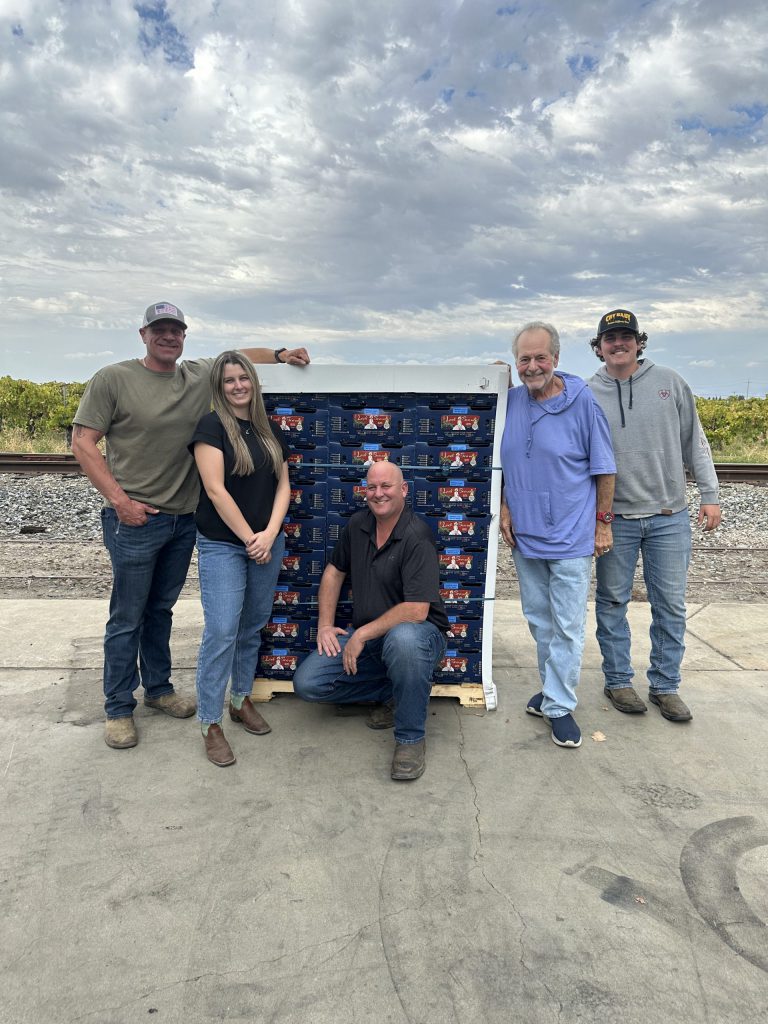The Guerriero Family Legacy: From Grapes to Glass

Tell us about your winery/winemaking/vineyard history and/or story
For over six decades, the Guerriero Family has been packing and shipping premium
California juice grapes. Our family started packing and shipping juice grapes in the Lodi region of the San Joaquin Valley in 1953 and eventually expanded to the Central Valley. This legacy began with Tony Guerriero, who turned a Bronx produce truck into a cross-country wholesale operation—and it continues today with third and fourth generation family members, Joe and his sons Joey and Tony Guerriero, and his grandchildren Dominic and Giovanna Guerriero. Many of our distributors today are the children or grandchildren of buyers our father and grandfather once served. This is not just business—it’s generational trust. In 2018, Cry Baby Wine was founded as a tribute to a dream that spanned three generations. Joe Guerriero brought to life what his grandfather and father had long envisioned: a locally hand-crafted, family-owned winery offering award-winning wines for every palate.
Across the U.S. and Canada, customers look for “the baby who is crying”—our Cry Baby label. It has become our signature, known for quality, flavor, and family pride. Many home winemakers swear by our grapes and wines, and that loyalty is earned with every bottle. Our experience in juice grapes runs deep. From pruning to harvest, we partner with some of California’s most respected farmers to ensure premium grape quality. We personally supervise vineyard selection and care, harvest timing, packing and shipping, and cold chain management. Our grapes are picked at peak maturity, forced air cooled to 32°F and shipped with the utmost care to preserve freshness and integrity.
What excites you about working with Barbera D’Asti in the Central Valley, and how does this region’s climate and terroir influence the grape compared to its traditional Italian roots?
What excites us about working with Barbera in the Lodi region of the San Joaquin Valley is how beautifully it bridges old-world character with new-world energy. In its native Asti, Barbera is prized for its high acidity, red-cherry brightness, and food-friendly elegance. Here in the Lodi region of the San Joaquin Valley, our warm days and fertile soils give the grape a riper profile—lush blackberry and plum alongside that signature tangy cherry core—while the natural acidity keeps everything lively and balanced. The result is a Barbera that’s both approachable and expressive, carrying a sense of place while honoring its Italian heritage. That contrast and harmony are what make it such a rewarding grape to work with.
What flavor profiles and structural elements (acidity, fruit notes, tannins) stand out most in Central Valley Barbera D’Asti?
San Joaquin Valley Barbera d’Asti–styled wines showcase ripe red and black fruit, lively acidity, smooth tannins, and a juicy, food-friendly structure, a California-sun expression of a naturally bright and approachable grape.
Are there qualities that make Barbera D’Asti especially approachable—or tricky—for home winemakers and smaller wineries?
Barbera is actually one of the most approachable grapes for smaller wineries and even home winemakers because of its naturally high acidity, juicy fruit, and soft tannins. It doesn’t require aggressive tannin management or years of barrel age to taste balanced—it can be bright, smooth, and food-friendly fairly early on. The tricky part is that the same acidity that makes it refreshing can feel sharp if the grapes aren’t fully ripe, and its lighter skin means you need to be thoughtful about color and oak use. But with a little care, Barbera rewards you with wines that are both expressive and inviting.
What techniques or approaches do you recommend to bring out the best in Barbera from the Central Valley? (e.g., managing acidity, oak vs. stainless, blending choices)
To bring out the best in San Joaquin Valley Barbera, we focus first on balance in the vineyard, picking when acidity is right, but fruit has developed full flavor. In the cellar, stainless steel fermentation keeps the fresh cherry and raspberry notes alive, while a touch of neutral or lightly toasted oak can add roundness without overwhelming its natural brightness. We also keep maceration gentle to avoid harsh tannins, since Barbera’s strength is its acidity and fruit, not heavy structure. Some producers blend in a small number of darker varietals like Syrah or Petite Sirah to boost color and body, but even on its own, Barbera really shines when you let its lively character lead the way.
Are there any misconceptions or common mistakes you see when people work with Barbera D’Asti that you’d like to clear up?
One common mistake with Barbera is treating it like a high-tannin grape. Winemakers sometimes over-extract, trying to pull out more structure, but that just makes it rough. Another is leaning too heavily on new oak, which can bury the fruit and throw the acidity off balance. And perhaps the biggest misconception is thinking its high acidity is a flaw—it’s actually Barbera’s greatest strength, the reason it’s so vibrant and food-friendly. In the San Joaquin Valley, that balance of ripe California fruit with naturally bright acidity is exactly what makes Barbera so rewarding when handled with a light touch.





